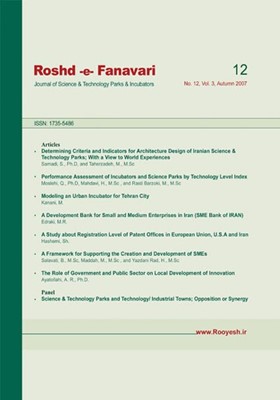Determining Criteria and Indicators for Architecture Design of Iranian Science & Technology Parks; With a View to World Experiences
Subject Areas : Technology ManagementSaeed Samadi 1 , Mahdi Taherzadeh 2
1 -
2 -
Keywords: Science and Technology park, Master plan, Architecture design criteria,
Abstract :
Technology parks were formed in 1960s as social foundations and as a part of the chain in knowledge - based development. From 1980s, the policy-makers pointed out to a sustainable development based on the technology infrastructure. Development of technology parks was promoted as part of this trend. As a result, there are currently more than 1500 STPs around the world. The development of STPs in Iran began since two decades ago and resulted in establishing a number of these parks. In some cases, challenges of allocating spaces, ambiguties in policies, poor funding, lack of rules and regulations, and bad strategic plannings have caused that some of theses parks are not successful in their goals and objectives. Sustainable master planning concepts for science & technology park sites prepares a way for sustainable design of research facilities. For the ultimate success research facility design it is critical that early master planning principles facilitate as many passive and sustainable techniques as possible. By using these techniques for science parks, the designers and science park managers will help to reduce costs, conserve resources, and reduce life cycle costs at the first stage, while providing a higher quality research environment. By reducing waste and planning for conservation of materials, the design team intends to improve the entire design and to build user processes. The outcomes show the reduction use of lands resources, and to reach a higher quality, more research productive facility and more money to devote to the core business of research. In this article, which is organized based on a descriptive analysis method, and an in-depth review on experiences from Australia and USA, we have attempted to analyse the master plan of those parks to evaluate the architecture considered to next figure out a proper trend relevant basis for development of STPs in Iran. In this view, essential factors such as scale, development process, accommodation and locality trend, space, are thoroughly assessed. Finally a case study was performed that investigates the master plan of KSTP from the point of view of regulations, specifications and key factors towards the success. Results obtained from this study can yield a framework for architecture and plan of STPs. It could also draw a bright outlook in the field to level the efficiency of STPs and draw a way toward the goals of policy- makers and STP managers.


